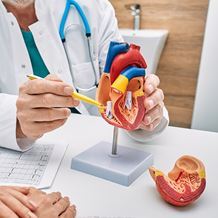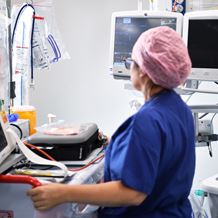What is cardiac ablation?
Cardiac ablation, also known as catheter ablation, is a surgical procedure that is used to correct heart rhythm problems. The treatment works by using radiofrequency energy to destroy small areas of heart tissue that are causing an irregular or rapid heartbeat. The energy applied to the heart tissue creates scar tissue which blocks the electrical signals and destroys the areas of the heart that have been causing the arrhythmia. Cardiac ablation may be recommended for patients with arrythmias when other treatments have been ineffective, or as a first option if the type of arrythmia traditionally responds well to this type of treatment such as Wolff-Parkinson-White Syndrome.
What does it do?
In a healthy heart, electrical pulses that make the heart contract follow a specific pathway through the heart. If there is any disruption to that journey, it can trigger an irregular heartbeat known as arrythmia. Cardiac ablation is a minimally invasive surgery that can help treat arrythmia by preventing the electrical impulses that cause an irregular heartbeat. The ablation technique destroys any abnormal tissue and restores proper function to the heart without causing any pain or residual problems. It is commonly used to treat atrial fibrillation, atrial flutter, supraventricular tachycardia and ventricular tachycardia.
How does it work?
Cardiac ablation aims to restore a normal heart rhythm by destroying any abnormal heart tissue that prevents the heart from functioning normally. The procedure uses heat or cold energy to destroy tissue and create scarring in specific areas of the heart that are triggering the abnormally fast heartbeat (tachyarrhythmia). This technique also works by blocking any abnormal electrical activity, breaking the circuit, and preventing it from entering the heart. Correcting the heart rhythm means the heart can pump blood effectively once again.
Why is it performed?
If there are abnormal cells in your heart tissue that are disrupting the electrical sequence in the heart, it can cause a fast or irregular heartbeat and prevent the heart from pumping enough blood around the body. This can lead to potentially dangerous symptoms such as feeling faint, shortness of breath, and general weakness. You may feel your heart pounding. If your arrythmia does not respond well to medication, your doctor may recommend cardiac ablation as a suitable alternative that will destroy the abnormal tissue and restore a regular heart rhythm without damaging the heart. Certain types of arrythmias such as Wolff-Parkinson-White Syndrome and supraventricular tachycardia are known to respond well to cardiac ablation.
Procedure
Cardiac ablation is usually caried out as a minimally invasive procedure. It can take up to four hours to complete.
- A small sheath is inserted into your groin to create an opening.
- Electrode catheters are threaded through the sheath and veins and up to your heart.
- X-rays are used to guide the catheters.
- The catheters deliver the energy required to destroy the abnormal heart tissue.
- The catheters and sheath are removed.
Recovery
After the cardiac ablation, you will spend some time in recovery while your heart is monitored. Most patients can return to their normal activities within a few days.
What's next?
If you have been experiencing heart-related symptoms, book an appointment with our cardiac services specialist today.
Our specialists in Cardiac Services
View all specialists






